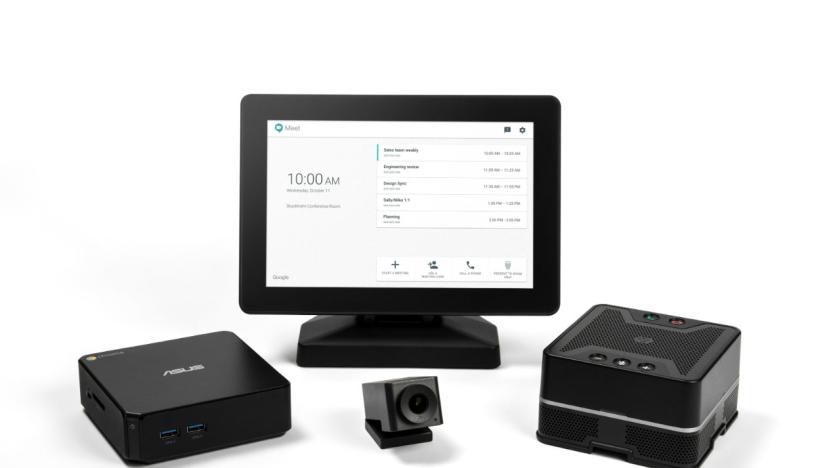videoconference
Latest

Skype chats are coming to Alexa devices
Aside from all of the Alexa-connected hardware, there's one more big development coming for Amazon's technology: integration with Skype. Microsoft and Amazon said that voice and video calls via the service will come to Alexa devices (including Microsoft's Xbox One) with calls that you can start and control just by voice. Last year the two companies announced plans to make Alexa and Cortana work together and it's taken a while to arrive, but now it's here. Amazon's push to make people buy more things via its assistant could provide a boost to Microsoft's aspirations of product integration in a way that didn't happen after the launch of the Xbox One and Kinect, which already featured voice control for Skype before Cortana and Alexa were on the scene.

Google's video conferencing kit gets an AI camera and display
Google has been trying to get a seat in your board room this year, courtesy of its tools and products for meetings. In March, it pivoted its Hangouts app to businesses, following it up with a $5,000 interactive display with collaborative cloud features. Not content with the two-punch software and hardware combo, the big G is now taking another stab at video conferencing. Remember the Chromebox for meetings bundle the company dropped in 2014? Well, it's back, courtesy of some rebranding and a bunch of upgraded products.

Google is ready to take over your office chat with Hangouts
Google's work of transitioning Hangouts from being its default chat app to a more business focus is nearly complete. First up is the formally announced Hangouts Meet. Sound familiar? That's because it semi-officially arrived at the first of the month. Now Google is ready to take it wide. At its core, Meet is all about making video conferencing faster and easier. That comes down to not needing any special software or logins for video chat -- just a shared link. No WiFi? No problem because people can dial in with a dedicated phone number too. So long as their organization is a G Suite Enterprise customer, of course. Meet will support video calls with up to 30 people.

Amazon Chime is yet another videoconferencing tool
Somehow, in 2017 it's still a chore to collect people for a conference call, much less one with video. Now Amazon is taking on Microsoft/Skype, Cisco and the rest with its new solution, Chime. Aimed squarely towards businesses, Chime comes out of the Amazon Web Services (AWS) side of things, running on the company's servers and promising "frustration-free meetings."

Google now lets you join Hangouts as a guest, no account needed
The worst thing about organizing an online meeting is squabbling over platform. Should you choose WebEx? Skype? Google? Your decision just got a little easier. As of today, you no longer need to have a Google account to join a meeting Hosted on Hangouts -- just a link.

KUBI telepresence robot arm for tablets now shipping, starting from $399
It was almost a year ago when we checked out Revolve Robotics' KUBI, a motorized tablet cradle that lets you remotely pan and tilt your device -- via an iOS app (Android version coming soon) or web portal -- during video calls. After missing its summer launch window, this US-made telepresence robot is finally shipping to its Indiegogo backers starting this week. Those who want in now can also order one through the company's website, albeit at much higher price points: the KUBI Hacker Edition for developers costs $399, whereas the prettier but otherwise identical KUBI Classic (pictured above) is asking for a steep $499 -- almost twice as much as the original intended price due to a change in tooling, for the sake of speeding up production. If you're really desperate for a Bluetooth LE robot arm for your tablet, order soon -- delivery is expected within three to four weeks. For now, you can get a glimpse of the first few KUBIs off the production line in the short clip after the break.

Google's living room plans reportedly included a Hangout-ready set-top box
As if the Google TV and Chromecast platforms (which are coexisting, if you hadn't heard) weren't enough, the Wall Street Journal reports there may be more living room focused projects brewing in Mountain View. According to sources, former Android head Andy Rubin demonstrated a Roku-style set-top box for partners at CES that had Hangouts as its main feature, with a video camera and motion sensor built-in for videoconferencing -- something Logitech tried once with its ill-fated Revue TV Cam, shown above. The report claims the box, capable of running Android apps, games and services like Netflix or Pandora, was scheduled to launch at I/O, but it's unknown whether or not it's still in development. Recent WSJ rumors have suggested Google is looking into IPTV and its own Android game system, so even as one mystery is revealed others pop up to take its place.

Hangouts come to Gmail, let you launch virtual meetings from your inbox
Google's been adding a lot of features lately to get us to Hangout, from providing digital moustaches to scheduling virtual soirees. Now, the company's aiming to get folks video conferencing from their inbox. That's right, you can now start a Hangout with up to nine friends or colleagues straight from Gmail with a click of a button. Users can expect better quality as compared to Gmail's old peer-to-peer video chats, and it provides access to people with an Android or iOS device and those on Google+ in a web browser. The new feature has already started making its way to users, and the rollout will continue over the next few weeks. Still not ready to mix your Hangouts with email just yet? Perhaps the pair of videos after the break will persuade you.

Daily iPad App: Fuze Meeting HD connects to telepresence systems
The flexible Fuze Meeting web conferencing platform already had a very solid iOS story, with the ability to schedule and start meetings from the iPad (including multiparty HD videoconferencing). Now, with the recently released version 4.0 of the app, the company is building a bridge to corporate high-end conferencing gear. The new app is compatible with Fuze's Hosted Telepresence Connect service, which allows iPad users to join in videoconference sessions with high-end installed systems from Cisco, Polycom, LifeSize and other vendors. These enterprise conferencing room systems don't come cheap, but adding the iPad clients into the mix expands their flexibility and may increase their utilization. (If you have to ask: the Telepresence Connect service starts at US$2,000 a month for connection to three endpoint systems.) In addition to the big-ticket feature, the new app version also includes the ability to start a meeting recording from the iPad, touch annotation of shared documents, and more. The free app paired with a trial Fuze account allows you to test out the meeting functionality; monthly plans start at $29.

InFocus Mondopad is a 55-inch multitouch display with an identity crisis (video)
What do you get when you mix buzzwords like "cloud" and "tablet" with an enourmous multi-touch monitor? The InFocus Mondopad, that's what. The company anticipates that this 55-inch 1080p high-definition panel "wall tablet", equipped with WiFi and a 720p webam / soundbar, will bring pad-like functionality to your next presentation in a big way. The proprietary software mimics the feel of a mobile OS -- only bigger and blander looking -- with basic apps like a whiteboard and web browser, as well as support for Office, JPG, and PDF files. Also inside is Intel's vPro tech, enabling remote access and file sharing with mobile devices -- or having dual-screen sessions with a 58-inch iPhone table, for instance. Pre-ordering one will run you $5,949 for delivery in July and VoIP service through Vidtel will cost $49 a month per connection. No word yet on whether a more portable version is the works, but you'll find some PR and a video walkthrough after the break. Update: We've been informed by InFocus that the Mondopad is running Windows 7 along with pre-loaded apps.

Sony makes floating-head telepresence avatars a reality, Sean Connery digs out gun and red speedos
The real world just got a little more Zardoz thanks to Tobita Hiroaki and his colleagues at Sony Computer Science Laboratory, who've built a telepresence blimp that projects the operator's face across its meter-wide surface. The looming, translucent face can float about like any other blimp; an interior camera allows the user to see where it's going. The whole thing is ominous in a completely different way from, say, a tiny googly-eyed robot perched on your shoulder, but something about its nearly silent movements still gives us the creeps – and unlike the Anybots QB, it's not going to pick up your scone from the café. But if your dreams include having others bow before your god-like visage, you'll have to wait awhile, as the technology's still in its early stages. In the meantime, you can practice intoning "Zardoz is pleased!" while watching the video above.

Kinect used to make teleconferencing actually kind of cool (video)
No matter how hard Skype and others try to convince us otherwise, we still do most of our web communications via text or, if entirely unavoidable, by voice. Maybe we're luddites or maybe video calling has yet to prove its value. Hoping to reverse such archaic views, researchers at the MIT Media Lab have harnessed a Kinect's powers of depth and human perception to provide some newfangled videoconferencing functionality. First up, you can blur out everything on screen but the speaker to keep focus where it needs to be. Then, if you want to get fancier, you can freeze a frame of yourself in the still-moving video feed for when you need to do something off-camera, and to finish things off, you can even drop some 3D-aware augmented reality on your viewers. It's all a little unrefined at the moment, but the ideas are there and well worth seeing. Jump past the break to do just that.

Fuze Meeting delivers multiparty video conferencing to iPad 2
The latest updates to Callwave's distributed conferencing platform, Fuze Meeting, have added a rather dramatic new feature that's perfect for iPad 2 owners (not to mention Android 'Honeycomb' tablets like the Motorola Xoom and older 'Froyo' devices): multi-party video conferencing. Meeting hosts who subscribe to the company's Pro plan (US$69 per month for unlimited meetings with up to 100 attendees) get the new face-to-screen capability. Video conferences support up to 10 simultaneous participants on the browser-based client (fewer simultaneous streams on mobile devices), and the quality tops out at 720p HD while adjusting down as needed for bandwidth limitations. We've covered Fuze before, and the core iPad app has kept its full feature set moving forward into the video conferencing realm. You can still share content directly from the iPad app (in fact, it's gotten easier, now that iOS 4.x multitasking means you don't have to relaunch the app if you switch into Dropbox to grab files). If you want to launch your camera, it's one tap to start the video conference, then a second tap to turn your direct view on. Image quality is comparable to FaceTime, although the default video window is much smaller. You can also use VoIP directly on the iPad to join Fuze conference calls, saving you from juggling phone and pad as you participate in the meeting. You can use the Fuze app's laser pointer tool to highlight elements within PPT, image/PDF, or video content as the meeting rolls along. Of course, the desktop/browser Fuze client has evolved along with the new features, and it also supports the 10-party video chat feature.

Apple FaceTime for Mac finally out of beta, available on the Mac App Store for $0.99
After a lengthy four-month beta trial, Apple's decided that it's about time to make FaceTime for Mac available to the masses, meaning any Mac user can finally do video chat with other Mac or iOS users. Unlike the app's free iOS counterpart, though, you'll have to chip in $0.99 on the Mac App Store for some enlarged video chat sessions. But hey, it's totally worth it, especially if you have a 27-inch screen to play with. [Thanks, kariminal]

Ittiam shows off four-way 720p HD video conferencing using Android, OMAP 4 (video)
Being Mobile World Congress, quite a few software vendors found themselves tucked into corners of bigger booths, eager and willing to showcase their latest work. Ittiam is one of those companies, relying on Texas Instruments' OMAP 4 platform to power its new HD video conferencing system. The demo shown here at MWC involved a foursome of TI development boxes, but the underlying platform was most certainly Android 2.2. Anil Kumar, the manager of Ittiam's video communications division, noted that the system would work just fine on Gingerbread and Honeycomb, enabling up to four devices (smartphones, tablets, whatever) to link up and enjoy a multi-faced call over a standard 3G network. Of course, the demonstration that we were shown used an Ethernet network for maximum stability, but the low-bitrate technology would allow bearable results on 3G networks (and better-than-average results on a 4G network). We were told that the company is in talks with "numerous" phone makers, in hopes of getting their VCS software integrated onto Android devices by the year's end -- think Qik, but for video conferencing -- but he couldn't hand out any specifics. Head on past the jump if you'd like to see a demo (and hear an awful lot more). %Gallery-116761%

Skype for iPhone upgrade lets it videocall Skype for TV, if you actually want to
There's a new update out for Skype on iOS devices today that which expands the new videocalling compatibility to "a wider selection of Skype clients and devices" by adding the h.264 compatibility necessary to chat with any Skype for TV clients. That's available on certain LG, Panasonic and Samsung HDTVs right now, while Sony and Vizio have both announced it will be in some of their new HDTVs coming out later this year. The ability to call mobile devices seems to give a big edge to Skype over other living room videochat setups from Cisco, Logitech or Microsoft's Kinect, but even with a compatible (& pricey)camera in hand, good luck finding someone out enjoying the world who wants to chat while you're chilling on the couch.

Panasonic launches Skype for 2010 VIERA Cast TVs
We managed to get an early look at Panasonic's TV-friendly implementation of Skype back at CES in January, but the company has just now finally activated the app on all of its 2010 VIERA Cast-enabled TVs (including the VT25, VT20, G25, and G20 Series). To take advantage of it, however, you'll also have to shell out $170 for Panasonic's TY-CC10W webcam, which supports both VGA and 720p video, and packs four unidirectional microphones, an echo canceling system, and some beam-forming technology that promises to deliver clear audio over a typical TV viewing distance of three to four meters. Head on past the break for the complete press release, as well as Panasonic's requisite old-people-don't-get-technology ad for the TVs.

Skype's group video calling beta now available for Windows
Mac and Linux users are still being asked to hold their horses, but Windows loyalists can begin testing out that hotly-anticipated group video calling feature today. Skype's latest beta, which was detailed earlier in the month, is now available to download for those willing to take the risk, with Skype 5.0 Beta adding support for "group video calls with up to four people." Hit that source link to get things rolling, and be sure to drop us a line once you and your four besties have had a chance to give 'er a go.

Skype to roll out five-way video calling next week, remote partying to surge
Well, it's taken long enough, Skype! Starting next week you will finally be able to video call with up to five people using the company's Group Video Calling feature. The beta, which will be available sometime for download during the week of May 10th, will initially be free, but Skype plans to start charging for the multi-party video fun later in the year. We're not sure if it will support HD calling, but you can bet your bottom dollar that corporations may consider replacing their surely complex videoconferencing setup with this. In other Skype news, the company is rolling out new calling plans to more than 170 countries -- from the looks of the PR after the break, it seems like it could end up saving you big time in comparison to the pay-as-you-go rates. We like savings, sure, but we'll be even more stoked should this ever land on camera-equipped smartphones and tablets.

Panasonic's TY-CC10W webcam joins Skype, HDTVs mostly because it can
Panasonic is back with more information on its four-mic packing HDTV camera accessory, the TY-CC10W. Skype friends who would like to see your living room without actually visiting can take a peek in either 30fps VGA or 720p/22fps h.264 encoded streams, courtesy of any nearby video phone compatible VIERA Cast TVs this can mount on top of and plug into via USB. We're (probably the only ones) waiting for a Chatroulette couch surfing client, but if you prefer your internet face-to-face meetings without the PC then ¥18,000 ($193) on June 11 will make it yours in Japan, no word on U.S. availability.










